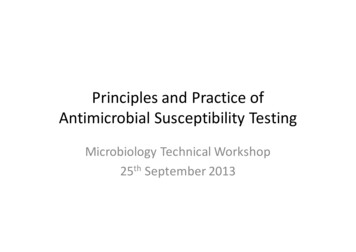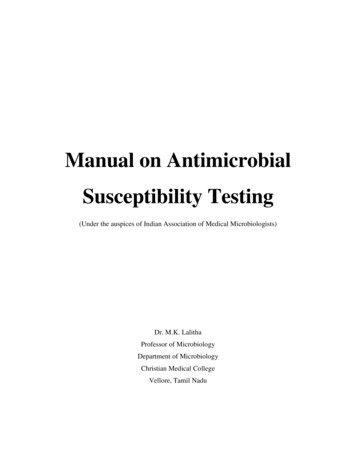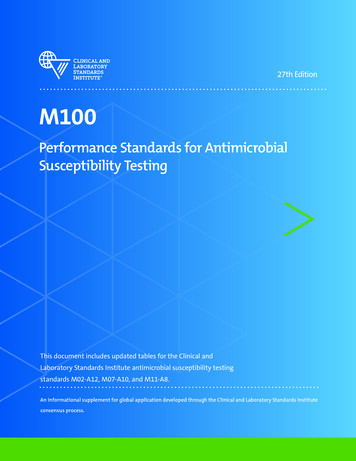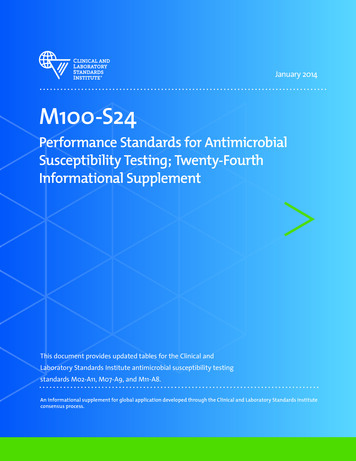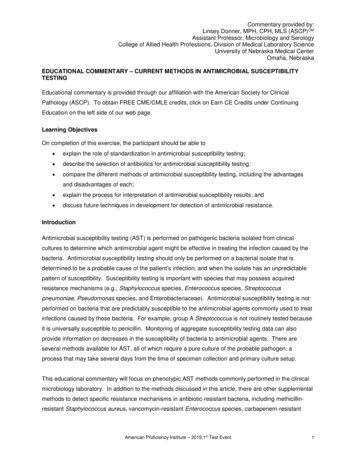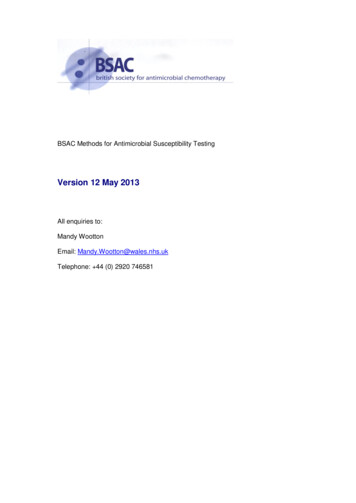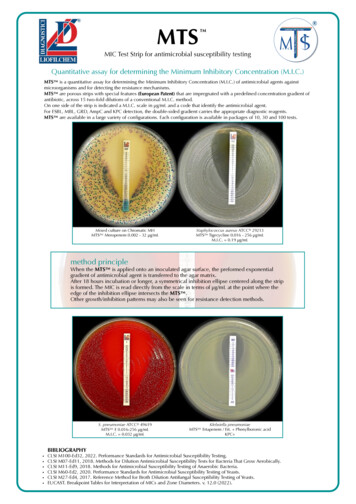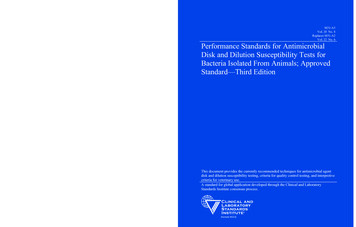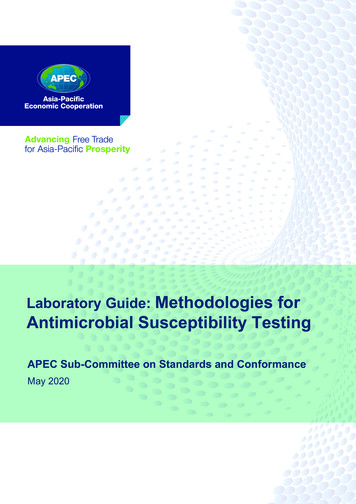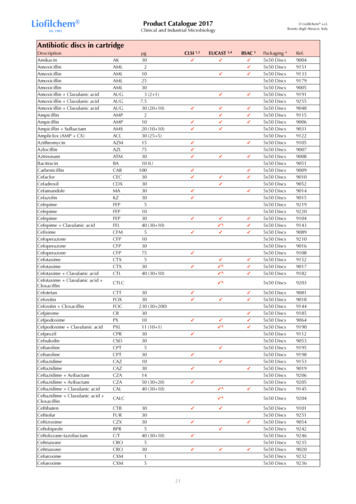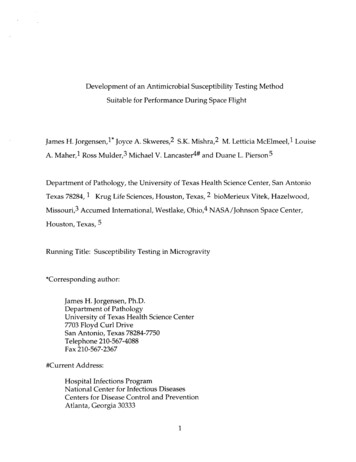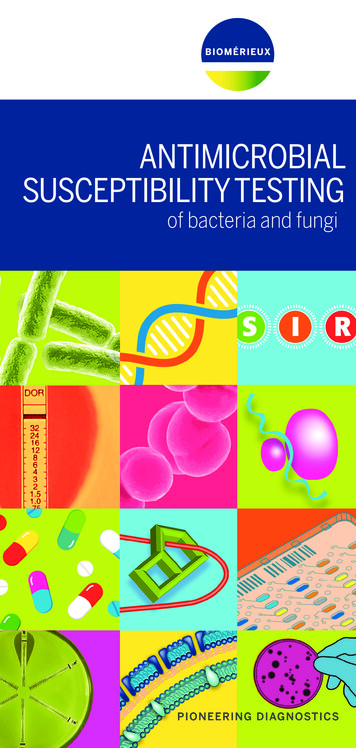
Transcription
ANTIMICROBIALSUSCEPTIBILITY TESTINGof bacteria and fungi
INTRODUCTIONQUESTIONSAND ANSWERSon AntimicrobialSusceptibility Testingof bacteria and fungiThis brochure is intended to provide succinctanswers to common questions about theperformance of in vitro antimicrobial susceptibilitytesting of bacteria and fungi and the value ofthe results in guiding antimicrobial therapy.This brochure was compiled with the help of Jan Bell,ACARE Laboratory, University of Adelaide,Adelaide, South AustraliaOf all the laboratory examinations performed daily by clinicalmicrobiologists, in vitro susceptibility testing is of particularclinical importance as an aid for selecting the most appropriateanti microbial therapy for individual patients, monitoring theevolution of microbial resistance, and updating empiricaltherapeutic strategies.The methodology for in vitro antibacterial testing and thecriteria for interpretation are well established. Antibacterialsusceptibility testing is routinely performed in microbiologylaboratories worldwide. Methods for in vitro antifungal testing andcriteria for interpretation have been developed more recently andare similar in concept to antibacterial testing. Susceptibility testingof certain antiviral agents (e.g. anti-HIV agents) is also establishedbut the methods and concepts are quite different. The scope ofthis brochure will be limited to a discussion of antibacterial andantifungal susceptibility testing.This brochure explains basic facts concerning the relevanceand procedures of in vitro susceptibility testing. It providesinformation on the essential elements required to perform and utilizesusceptibility testing as a tool for optimizing anti-infectioustherapy.1
QUESTIONS AND ANSWERS1What is in vitro susceptibilitytesting?Susceptibility testing measures the level at which a particularantimicrobial inhibits the growth of a specific microbial strain.A variety of laboratory methods can be used to measure thein vitro susceptibility of microbial pathogens to antimicrobial agents.Methods should be standardized based on international standards suchas EUCAST, CLSI and ISO.the empirical therapy and/or indicate appropriate alternative agentsfor treatment. Alternative agents may be required when resistanceis detected or the patient experiences an adverse reaction to theempirical agent. Often, it is possible to identify appropriate agents fororal step-down therapy or narrower spectrum agents likely to be aseffective as the broader empirical therapy.“Sensitivity” is a widely used term and is essentially synonymous withsusceptibility in the context of susceptibility testing.A second important purpose of routine in vitro susceptibility testing isto monitor the evolution of bacterial and fungal resistance. Thisrole requires periodic statistical analysis of the accumulated levelsof resistance per species, type of specimen, and patient, in order toguide the initial empiric choice of antimicrobial therapy while awaitinglaboratory test results. The pattern of antimicrobial resistance byward, healthcare establishment, region or country guides empiricantibiotic therapy choices and antibiotic formulary decisions.Detailed statistical analysis enables the detection of outbreaks,especially in the hospital or long-term care setting, caused by multiresistant bacteria, which justify investigation and appropriate infectioncontrol intervention. The detection of a new resistance pattern or alarge number of patients infected with multi-resistant bacterial strainsat one time and in the same place may indicate the need for implementationor change of infection control practices.2Why performin vitro susceptibility testing?The goal of in vitro antimicrobial susceptibility testing is to assessthe activity of an antimicrobial agent on a bacterial or fungal strain in order to predict the likelihood of in vivo efficacy ofantimicrobial therapy when the antimicrobial is administered topatients.The main purpose of routine in vitro susceptibility testing in theclinical microbiology laboratory is to guide physicians in selectingantimicrobial therapy for treatment of individual patients. Thesusceptibility testing is performed on bacterial and fungal strainsisolated from individual patients and presumed to be the etiology oftheir infection. The physician utilizes the susceptibility test resultalong with other available clinical information (e.g. site of infection,severity of infection, immune status of patient, co-morbidities, etc.)to select the optimal therapeutic agent for that particular patient’sinfection. Usually the susceptibility test results become availableafter initiation of empirical antimicrobial therapy. When this occurs,the susceptibility test results serve to confirm the appropriateness of2Data from routine antimicrobial susceptibility testing performed inclinical microbiology laboratories therefore influences the therapeuticdecisions for current and future patients.DUAL PURPOSE OF SUSCEPTIBILITY TESTING:Individual (to guide the selectionand modification of antimicrobial therapy)and Epidemiological3
ANTIMICROBIAL SUSCEPTIBILITY TESTING3QUESTIONS AND ANSWERSWhen should a susceptibility testbe performed?In general, assuming that standardized testing methodologies havebeen developed, susceptibility testing is indicated for microor ganismscausing infections warranting antimicrobial therapy when thesusceptibility cannot be reliably predicted based on the knowncharacteristics of the organism.In vitro susceptibility testing methodology is well established forbacteria and is considered a routine part of the culture process(Clinical Laboratory Standards Institute (CLSI), 2009 and EuropeanCommittee for Antimicrobial Susceptibility Testing (EUCAST), 2000,2003). In vitro susceptibility testing is usually performed each timebacteria considered to be responsible for a patient’s infection areisolated from a clinical specimen.Susceptibility testing for yeast species is less commonly performed andis not available for all species. There are published reference methods(CLSI and EUCAST) and some commercial products are available. Eachlaboratory will determine the need for routine testing of yeast isolatesfrom clinical specimens based on the need of the patient population.Reference methodology for in vitro testing of mould species is underdevelopment and currently only available from specialised mycologylaboratories.When the same species is isolated from specimens taken fromdifferent body sites (e.g. urine and blood) or from multiple specimensfrom the same body site (e.g. multiple blood culture bottles arepositive), the laboratory may elect not to perform susceptibility testingon all of the isolates from the patient.Sometimes microbiologists cannot definitely determine if susceptibilitytesting is required, without obtaining the clinical information that onlya clinician can provide.For example, a commensal bacterium (e.g. Staphylococcus epidermidis)is occasionally isolated from sterile site cultures (e.g. blood, joint fluid,cerebrospinal fluid) due to inadequate decontamination of the skinduring specimen collection.Susceptibility testing should not be performed on probable contaminants.However, the same S. epidermidis can cause a true bloodstream infectionin an immuno-compromised patient or an infection at a specific bodysite (e. g. prosthetic joint, cerebrospinal fluid shunt) in which case,susceptibility testing should be performed.Clinical symptoms can also be a determining factor when decidingwhether to perform susceptibility tests (e.g. diagnosis of urinary tractinfection with a low bacterial count).Establishing the need for susceptibility testingrequires a close working relationshipbetween microbiologists and clinicians.Susceptibility testing should not be routinelyperformed on organisms that are partof the normal bacterial flora and usually notconsidered pathogenic.45
ANTIMICROBIAL SUSCEPTIBILITY TESTING4QUESTIONS AND ANSWERSCan susceptibility and/orresistance of bacteria to anantibiotic be predicted?Each antibiotic is characterized by a natural spectrum of antibacterialactivity. This spectrum is the list of bacterial species which, in theirnaïve (wild-type) state, have their growth inhibited at a concentrationknown to predict efficacy in vivo. These bacterial species are saidto be naturally susceptible to this antibiotic. Bacterial specieswhich are not included in this spectrum are said to be naturally(intrinsically) resistant.v N atural resistance is a stable characteristic of all strains ofthe same bacterial species. It occurs as a result of themicroorganism’s genetic composition. This intrinsic resistancemeans that the antimicrobial agent is unlikely to ever be usefulto treat an infection due to strains of this species. Knowledgeof naturally resistant species enables prediction of the likelyinactivity of a molecule in relation to the identified or probablebacterial pathogen. It sometimes constitutes an identificationaid as some species can be characterized by their naturalresistance.EXAMPLES : Natural resistance of Klebsiella pneumoniae to aminopenicillins (ampicillin,v Acquiredresistance is a characteristic specific to somestrains, within a naturally susceptible bacterial species, in whichthe genotype has been modified by gene mutation or geneacquisition. Contrary to natural resistance, acquiredresistances are evolutionary and their frequency is oftendependent on the amount of exposure to antibiotics. Given theevolution of acquired resistances, the natural activity spectrumis no longer sufficient to guide the choice of antibiotic therapyfor numerous species. Acquired resistance results from amutation in the microbial chromosome or the acquisition ofextra-chromosomal DNA. In bacteria, the spread of resistancemechanisms occurs through vertical transmission (parent todaughter cells) of inherited mutations from previous generationsas well as horizontal spread of mobile genetic elements such asplasmids (moving between cells and often between different species ofbacteria).Acquisition of antimicrobial resistance mechanisms can renderpreviously useful antimicrobial agents useless for treating moststrains of the species (e.g. penicillin and Staphylococcus aureus).Therefore, susceptibility testing becomes essential for thedetection of acquired resistance.amoxicillin) due to a β-lactamase (mostly SHV-1). Natural resistance of Proteus mirabilis to tetracyclines and colistin (due to naturaltargets with reduced binding ability).NATURAL RESISTANCE:permanent characteristic of the species, which isknown and predictable.ACQUIRED RESISTANCE:characteristic of some bacterial strains, which isevolutionary, unpredictable and justifies the needfor susceptibility testing.67
ANTIMICROBIAL SUSCEPTIBILITY TESTINGQUESTIONS AND ANSWERSv E xamples of natural resistance (adapted from Livermore DM et al., oticsE. EnterobacterSerratiaPenicillin GAminopenicillinAminopenicillin beta-lactamase esGlycopeptidesColistin Natural resistanceC1G : 1st generation cephalosporinsC2G : 2nd generation cephalosporinsC3G : 3rd generation cephalosporins89
ANTIMICROBIAL SUSCEPTIBILITY TESTING5What is an antibiotic clinicalspectrum?In order to take into account the evolution of acquired resistancesand therefore provide clinicians with useful information when choosingempiric antibiotic therapy, the concept of clinical spectrum complementsthat of the natural spectrum.The clinical spectrum is defined for each antibiotic and in somejurisdictions is included in the technical package insert which isapproved during the registration of antibiotics. This spectrumis initially defined by clinical breakpoints, which are devised byintegrating microbiological data (Minimum Inhibitory Concentrations– MICs, and wild-type MIC distributions), pharmacokinetics/pharmaco dynamics, and clinical outcome data. Regulators may also definesusceptible species as only those species for which the clinical activityof the product has been demonstrated. Strains other than those definedby the regulator may still be susceptible to an antimicrobial agent at thesame clinical breakpoints. The treating clinician then takes responsibilitywhen using that agent to treat infections caused by such strains.The clinical spectrum is regularly revised to take into account theevolution of acquired resistances. The prevalence of resistance mayvary geographically and with time for selected species and localinformation on resistance is desirable, particularly when treatingsevere infections.CLINICAL SPECTRUM OF ACTIVITY:useful to guide empiric antibiotic therapy depends on the clinical breakpointsand frequency of resistanceand the in vivo activity of the antibioticQUESTIONS AND ANSWERS6How is the susceptibility to anantimicrobial measured?Most susceptibility testing is growth based. It involves exposinga pure culture of a microorganism to a range of concentrations ofan antimicrobial agent and observing the presence or absence ofgrowth after a period of incubation. The results can vary widelydepending on the conditions of testing. It is therefore imperative touse standardized methods.When performing in vitro susceptibility testing, technicalfactors must be controlled by rigorous standardization of all theanalysis stages (purity and density of the bacterial inoculum, mediumcomposition, reagents, incubation conditions, reading method and biological and clinical criteria for interpretation of these results). Detailedand continuously updated international recommendations are available, such as those compiled by the CLSI and EUCAST. Quality controlprocedures for evaluating analytical accuracy and precision must alsobe applied regularly in order to guarantee the quality of the susceptibilitytest.Broth dilution was one of the earliest antimicrobial susceptibility testing(AST) methods. Originally performed in test tubes (macrobroth dilution),it has been miniaturized into microtiter plates (microbroth dilution). Twofold dilutions of the antimicrobial are made in a nutrient broth and theneach well is inoculated with a standardized number of microorganisms.As defined by standardized methodology, the plates are incubated ata defined temperature for a defined period of time. The lowest concentration of antimicrobial with no visible growth is the minimum inhibitoryconcentration (MIC).Modern technology has allowed miniaturization and automation ofbroth dilution methodology which has reduced the time to results. Ingeneral, for routine bacterial susceptibility testing, results are availablein several hours to a day.Automation increases precision, minimizesoperator error, and provides traceability toAST methods.1011
ANTIMICROBIAL SUSCEPTIBILITY TESTINGThe disk diffusion method involves placing antimicrobial impregnateddisks onto an agar surface that has been inoculated with a standardizedsuspension of microorganism. After a defined period of incubation,the zone of no growth around each disk is measured and interpretedbased on published interpretive criteria, which have been developed bycomparison with MIC methods.7What is a MIC and howis it used?v Routine Laboratory methods for MIC determinationGradient diffusionMANUAL METHODSAntimicrobial gradient diffusion is another form of AST in which aconcentration gradient is established in an agar medium onto whicha standardized suspension of microorganism is inoculated. Thismethod has the capability to generate a MIC value across an extensiverange of dilutions for a wide range of organism/antimicrobialcombinations.QUESTIONS AND ANSWERSThe basic measurement of the susceptibility of a microorganismto an antimicrobial agent is based on the determination of theminimum inhibitory concentration (MIC).The MIC is a measure of antimicrobial potency. It is the fundamentalreference value that enables a range of antimicrobial activity to beestablished for different microbial species, and to which all other testingmethods are compared. Each microbial species will have a unique MICdistribution in the naïve or wild-type state (EUCAST website), i.e. not allmembers of a species will have exactly the same wild-type MIC.Various laboratory techniques enable the MIC value to be measured orestimated semi-quantitatively in routine use (see opposite).Using the MIC, a tested strain can then be categorized according to itssusceptibility for the antimicrobial being tested. This strain is said to beSusceptible (S), Intermediate (I) or Resistant (R) to the antibacterialor antifungal agent.12Timeto resultsBacterial growthmeasuredaccording toan antibioticconcentrationgradient18 hrsBacterial growthmeasuredaccordingto 2 or severalantibioticconcentrations18 hrsBacterial growthmeasuredaccording to one(4 hrs)or 2 antibioticconcentrations(18 hrs)4 hrsto18 hrsKineticanalysisof bacterialgrowth4 hrsto18 hrsMicrotiter plateSEMI-AUTOMATED OR AUTOMATED METHODSThe MIC is defined as the lowest concentration of a range of anti biotic dilutions that inhibits visible growth of bacteria within a definedperiod of time.ATB stripPrincipleATB - rapid ATBMicrotiter plateVITEK 2 cards13
ANTIMICROBIAL SUSCEPTIBILITY TESTING8What are clinical breakpoints?In general, two antimicrobial concentrations, known as «breakpoints» or interpretive criteria determine three categories:Susceptible (S), Intermediate (I), and Resistant (R). Below (or equalto) one concentration, the clinical isolate is categorized as S, above(or equal to) the second concentration, it is categorized as R, andbetween these two concentrations, it may be categorized as I.For some newer antimicrobials, where resistance is very rare orunreported, the categories may be Susceptible and Non-susceptible.Although the term “breakpoint” has been used in a wide range ofcontexts, it should be reserved for the values determined by themethods described below.Breakpoints are developed through a detailed examination of MICdata and distributions, resistance data and mechanisms, pharmacokinetic and pharmacodynamic properties of the antimicrobial andavailable data on clinical outcome (by MIC of the infecting strain ifpossible). They are regularly reviewed and revised as appropriate whennew information becomes available in one or more of these data sources.Breakpoints are used by clinical microbiology laboratories tocategorize and report clinical isolates as S, I or R, which will thenassist physicians in selection of antimicrobial therapy.AST interpretive category classifications are based on the in vitroresponse of an organism to an antimicrobial agent at levelscorrelated to blood or tissue levels attainable with the usuallyprescribed doses of that agent. The intention is to correlate clinicalbreakpoints with the likely performance of the drug when used totreat an infected patient.Breakpoints are of two types: MIC breakpoints, applied to broth or agar-based methods,including the automated methods such as VITEK 2. zone diameter breakpoints, used to categorize test results for thedisk diffusion method. Disk diffusion breakpoints compare the MICsdetermined using a reference MIC testing method with the zonediameters generated by standardized disk diffusion on large numbersof relevant strains, using sophisticated statistical techniques.14QUESTIONS AND ANSWERS9What do S, I, R categories mean?For a given antimicrobial, a bacterial or yeast strain is classifiedaccording to the following criteria.v Susceptible (S)Susceptible means that the infection caused by that strain is highlylikely to respond to treatment, at the site from which the strainwas isolated, with the usual antimicrobial regimen for that type ofinfection.vIntermediate (I)Intermediate means that the infection is likely to respond to higherdosing regimens (where possible) or because the antimicrobial isconcentrated at the site of infection. It is also a buffer category toensure day-to-day test variation does not result in a resistant isolatebeing categorized as susceptible or vice versa.v Resistant (R)Resistant means that the infection caused by that strain is unlikely torespond to treatment with any regimen of the antimicrobial agent.vSusceptible-dose dependent (SDD)The “susceptible-dose dependent” category implies clinical efficacywhen a higher than normal dosage of a drug is used and maximal bloodlevel achieved. This is currently reserved for certain antifungal drugs(e.g. fluconazole).vNonsusceptible (NS)This category is used for organisms that currently have only asusceptible interpretive category, but not an intermediate orresistant interpretive category. It is often given to new antimicrobialagents for which few or no resistant clinical isolates have yet beenencountered.15
ANTIMICROBIAL SUSCEPTIBILITY TESTINGQUESTIONS AND ANSWERS10 What criteria are used to selectthe antibiotics to be tested?The selection of the antimicrobial agents to be tested must be carefullydetermined depending on the microbial species and their naturalresistance, local epidemiology of acquired resistances, the site ofinfection and local therapeutic options (formulary).Each laboratory selects which antimicrobials are appropriate to testand report for each organism isolated. The antibiotics tested are those of therapeutic value for the typeof infection and the body site from which the specimen has beencollected.D ue to the importance of acquired resistance, it is sometimes necessaryto test antibiotics which serve as resistance «markers», i.e. which areuseful to detect resistance mechanisms.EXAMPLE: Ertapenem is an excellent carbapenemase resistance marker for Enterobacteriaceae.The choice of antibiotics to be tested is madein relation to their therapeutic value and theirusefulness to detect resistance mechanisms.11 How are susceptibility resultsreported?appropriate agents for the treatment of the infection and withholdingresults for agents which may be effective but are unnecessarily broador are only used as reserve agents.For example, the laboratory may choose ”cascade reporting”, e.g.to withhold the results of a third-generation cephalosporin and acarbapenem for a strain of Escherichia coli which is susceptible toearlier generations of cephalosporins and beta-lactamase inhibitorcombinations, or to modify the report to include additional agentswhen certain resistances are detected.12 What is antibiotic equivalence?Equivalence is the prediction of in vivo activity for one antimicrobialbased on results obtained by testing another, related antimicrobialagent. In this case, only a category result (S, I, R) can be reported.EXAMPLE: Equivalence between erythromycin which is tested and other macrolides(e.g. azythromycin and clarithromicin) which are not tested. The category (S, I, or R)result for the other antimicrobials can be predicted from that obtained for erythromycin.It is possible to test a restricted numberof antibiotics without limiting therapeuticpossibilities.Susceptibility testing results are usually reported as S, I, or R for eachantimicrobial tested for that isolate. Most laboratories will also includethe actual MIC value, as it provides critical information that assistsclinicians in making therapeutic decisions.Often laboratories report only a selection of the antimicrobialstested, those that are most appropriate or commonly used.This selected reporting is often preferred because it assists in“antimicrobial stewardship” by guiding the prescriber to the most1617
ANTIMICROBIAL SUSCEPTIBILITY TESTINGQUESTIONS AND ANSWERS13 Why do some patients withsusceptible isolates fail therapy?A MIC is an in vitro measurement (a laboratory assay) that provides anestimate of antimicrobial potency. It does not take into account hostfactors, especially the kinetics of the agent in an individual host, whichare just as important as susceptibility test results in determining theoutcome of treatment. Therefore, the susceptibility of a microorganismin vitro does not always assure successful therapy. As a corollary,resistance defined in vitro often, but not always, predicts therapeuticfailure.When multiple reports of the correlation of therapeutic outcome with invitro susceptibility are examined (Rex J and Pfaller MA 2002), a patternreferred to as the “90-60 rule”, or natural response rate, emerges. This90-60 rule observes that infections due to susceptible isolates respond toappropriate therapy approximately 90% of the time, whereas infections due to resistant isolates (or infections treated with inappropriate anti biotics) respond less than 60% of the time. Although thereare some important exceptions, this rule is relatively robust and holdswhether the outcome measurement is clinical response, bacteriologicalresponse, or mortality.v Antimicrobial Drugs: why do they sometimes fail?PROPERTIES OFANTIMICROBIALImmune SystemUnderlying diseasesBarrier statusForeign bodiesHOST FACTORSCNSIntravascularPulmonaryNeed for surgicalintervention18In VitroTestingMIC & SIRPK and PDMetabolism and EliminationTissue penetrationMethod of actionAdverse event profilePATHOGENSpeciesVirulence factorsResistancemechanismsSITE OF INFECTION19
ANTIMICROBIAL SUSCEPTIBILITY TESTING14 How do bacteria acquireresistance?v The genetic mechanism of acquired resistance can be: The mutation of a gene involved in the mode of action of theantimicrobial that results in an alteration in the moleculethat is the target of the antimicrobial. Most often, this type ofresistance mutation results in reduced antimicrobial binding tothe target. This mechanism is the most commonly observedfor the following antibiotics: quinolones, rifampin, fusidic acid,fosfomycin, antituberculosis drugs, and sometimes cephalosporins.QUESTIONS AND ANSWERSModification of theantimicrobial target resultingin reduced binding.EXAMPLE: Modification of PenicillinBinding Proteins (PBPs) of:- oxacillin-resistant Staphylococcusaureus (known as MRSA*).- penicillin-resistant S. pneumoniae.* methicillin-resistant Staphylococcus aureusEXAMPLE: Resistance to quinolones by modification of DNA gyrase inEnterobacteriaceae. Acquisition of resistance genes transferred from a strainbelonging to an identical or different species, usually on amobile genetic element such as a plasmid. Some antibioticsare particularly affected by this mechanism: ß-lactams,aminoglycosides, tetracyclines, chloramphenicol, sulfonamides.EXAMPLE: Resistance to ampicillin in E. coli and Proteus mirabilis.Impermeability of thebacterial outer membraneby alteration or quantitativedecrease of porins.EXAMPLE: Imipenem-resistantPseudomonas aeruginosa.v The biochemical mechanism of resistance can be due to:Production by the bacteria ofenzymes inactivating theantibiotic.EXAMPLE: Penicillinase in staphylococci,extended spectrum ß-lactamase (ESBL) inEnterobacteriaceae.20Efflux mechanism: expulsion ofthe molecule by active transport.EXAMPLE: Tetracycline-resistantstaphylococci.21
ANTIMICROBIAL SUSCEPTIBILITY TESTING15 Can antimicrobials «induce»resistance?Antimicrobials do not cause resistance, but may allow resistantmutants to proliferate by eliminating susceptible microorganisms.QUESTIONS AND ANSWERS17 What is cross-resistance orassociated resistance?vThe increase in the frequency of resistant strains is often linked toincreased use of a specific antimicrobial.R esistance to oxacillin in Staphylococci confers in vivo resistance to almostall ß-lactams.In certain cases, a resistance mechanism can affect antibioticsfrom different classes.16 Which methods enableFor the moment, only certain techniques enable the direct detectionof biochemical mechanisms (example: detection of ß-lactamase byhydrolysis of the indictor ß-lactam nitrocefin) or genetic determinantsof resistance (example: detection of the mecA gene responsible forstaphylococcal resistance to oxacillin).class or subclass of antibiotics.EXAMPLES:F or Streptococci, resistance to 14- and 15-membered macrolides can bepredicted by testing erythromycin.This is known as selection pressure.resistance mechanisms to bedemonstrated in vitro? Cross-resistance is a resistance mechanism that affects an entireEXAMPLE: Resistance due to impermeability to tetracyclines also affectschloramphenicol and trimethoprim.v Resistances are said to be associated when several resistantmechanisms involving different antibiotic classes frequentlyoccur together. Associated resistance is often plasmid-mediated, andin Gram-negative bacteria can often be encoded by genes strungtogether inside an integron.EXAMPLE: Resistance to oxacillin in staphylococci is often associated withresistance to quinolones, aminoglycosides, macrolides and tetracyclines.Susceptibility test results can suggest the presence of a resistancemechanism.2223
ANTIMICROBIAL SUSCEPTIBILITY TESTINGQUESTIONS AND ANSWERS18 Why is it necessary to interpretsusceptibility test results?The rapid evolution of acquired resistance mechanisms by clinically significant bacteria and the sometimes weak expression of these resistancecharacteristics may require the use of tests in addition to those routinely performed. The goal of the additional tests is to avoid categorizing bacteria as susceptible when they express only low-level resistancein vitro but are likely to cause therapeutic failure in vivo.To avoid this, susceptibility testing must be interpreted to discerneven a weakly expressed resistance mechanism (by comparingresults for each antibiotic). Therefore, with appropriate interpretation, astrain initially testing as susceptible will be categorized as I or R.“Interpretive reading” can also be enhanced by the use of expert systemsthat are capable of examining resistance profiles and making predictionsabout other agents not tested or their likely therapeutic efficacy (seeQuestion 19).vEXAMPLES: Strains of Staphylococcus aureus that test Resistant to methicillin or oxacillin (MRSA)may test Susceptible in vitro to other beta-lactams, especially
In vitro susceptibility testing methodology is well established for bacteria and is considered a routine part of the culture process (Clinical Laboratory Standards Institute (CLSI), 2009 and European Committee for Antimicrobial Susceptibility Testing (EUCAST), 2000, 2003). In vitro susceptibility testing is usually performed each time
